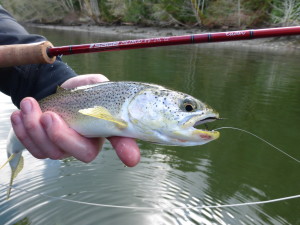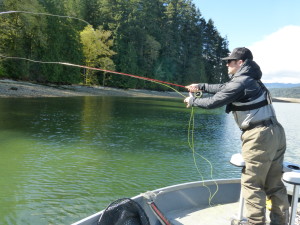Finally, spring seems to have made an appearances in Western Washington. Beautiful sunny days, and flat calm water on Hood Canal made for great weather. Fishing has been great also, with many of our coastal Sea-Run Cutthroat now emerging from their spawning streams. The fish we have been catching are hungry, and once again are keying in on the annual chum fry hatch and migration. We have been catching and releasing good numbers of fish recently, mostly in the 12-14 inch class – all very nice healthy wild Sea-Run Cutthroat.
 Sea-Run Tactics:
Sea-Run Tactics:
What I mean by SRC tactics is how to approach a beach by foot to fish it. I’ll lay out some of the key indicators to look for in a beach and then how to start fishing it. This time of year with the chum fry noodling along the beaches in rather shallow water, anglers should approach cautiously making sure not to jump right in splashing around. This could spook Sea-Run Cutthroat (SRC) right from underneath you and you might miss a shot at a nice fish. Rather, stand back as you approach a beach, and take a minute or two to survey what is happening on the water. Quite often, SRC’s will be in 6-12 inches of water right in close to shore either staging behind structure with current moving by or aggressively chasing chum fry, sculpins or other baitfish along beaches that provide a food source and cover.
 Questions to ask yourself as you approach a beach:
Questions to ask yourself as you approach a beach:
Do you see any chum fry activity, or active fish attacking chum fry, sand lance or other baitfish? What is the current doing – meaning which direction is it moving? Where is the best place to start fishing, and where is your best estimation of where the fish will be located? Is there structure (rocks, oyster beds) that might hold fish? Once you take a minute or two to survey the beach, and you have locked down some of information from the questions above it is time to get started.
Similar to river fishing, these fish hold in certain areas for certain reasons – almost always related to a food source, current bringing the food to them and protection from predators.
- Start beach fishing in close to shore first, and then work your way out further with each cast. This allows you a shot at those shallow running fish that are in close to shore. Beaches with current, like a river, are my favorite to fish. Similar to swinging flies for steelhead take a step or two down current after each step to allow maximum coverage of surface area. Remember, don’t pull the fly out of the water to quick as you are retrieving. I like to bring the fly right into almost the tip of my guide. Many times SRC’s will chase it right to the end as you begin to pull the fly out and begin another cast.
- Cast and retrieve at a 45 degree angle to the shore. This allows keeping your fly in the zone longer, particularly if fish are holding in a certain depth along the shoreline.
- Give it ACTION! SRC’s love action to a fly. A triple strip and pause works well, particularly with conehead or dumb bell eyed flies that sink on the pause.
- See a jumper – cast to it! Active fish show themselves and are aggressive. These guys love a good meal flung their way and nine times out of ten will attack your fly.
- Fly switch – if it isn’t working and there are active fish in front of you match the hatch. Yes, sometimes we have to get back to the basics and try to match what these guys are eating.
- Last, but not least – handle them gently. Make sure to use single barbless hooks and a rubber catch and release net. If possible unhook them with pliers, rather than grabbing them.
Hope these tips help bring a few more SRC’s to the end of your line.
